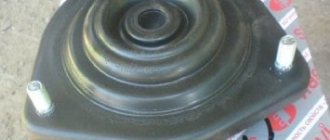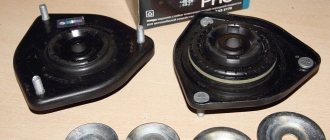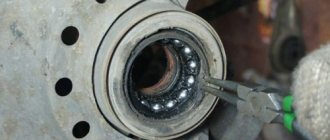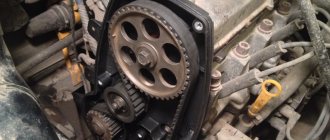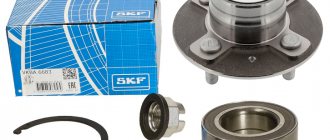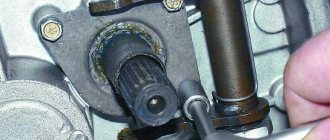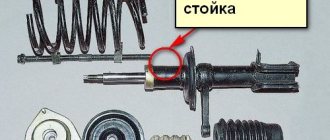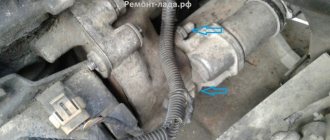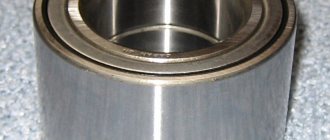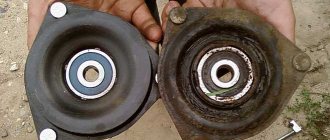The MacPherson front suspension, due to its simplicity, manufacturability and low unsprung masses, quickly captured a large part of the automotive market, starting in the last quarter of the 20th century. One of its structural components, namely the upper support bearing, looks like a good example of how the most important advantage of the circuit, in terms of resource, can be turned into one of its weak points.
Read more about what this unit is, what problems car owners have to deal with and how to fix them.
Replacement of support bearings VAZ-2113, 2114, 2115
The support bearing, to the inner part of which the front strut is attached, and the body rests on the outer part, serves to movably connect the front strut and the body, softening all kinds of shocks and vibrations coming from the shock absorber. A timely replaced bearing will eliminate the problems of overhauling the entire chassis. When the hood is open, the support bearings are visible above the wheels on both sides.
Basic faults
Wear of the VAZ-2114 bearing is the main reason for replacing it. A knock in the suspension, which is heard when driving on a bumpy road or when turning, should alert the driver. Checking the bearing is simple: you need to grab it with your hand and rock the car; a knock that may appear indicates the need for repairs.
The dirt that is abundant on the roads is one of the causes of defects in the mechanism. The support is practically not protected from it.
It is worth checking the condition of the supports at least after 20,000 km.
If the knocking does not go away, then think about this: a completely worn bearing can break completely, and this will lead to the strut breaking through the hood. Repair costs will be completely different.
Replacing a bearing is not that expensive - about 500 rubles per part, 1000 rubles for a replacement at a service station.
The most popular bearings are ss20. They perform best under relaxed driving conditions, although some drivers complain about their harshness.
For a more sporty driving style, with sharp stops and fast accelerations, Acomi bearings have proven themselves well.
Don’t skimp on spare parts; try to buy support bearings from a trusted manufacturer. When choosing, you need to rely on your own driving style and the characteristics of the road surface.
The main signs of a malfunctioning front bearings
The following signs indicate a unit failure:
- A clearly audible and clearly felt knock that appears in the area of the front wheel arches every time the steering wheel is turned. Quite often such a knock is transmitted through the steering wheel. In addition to knocking sounds, there are creaks and dull noises when turning.
- Significant deterioration in vehicle controllability, deterioration in the quality of steering.
- Spring breakage.
Of course, knocking may not always be transmitted to the steering wheel. It all depends on the type of car, its brand and design features. But this should not reassure the driver. Failure to take timely measures can lead to complex repairs.
How to spot signs of trouble
If you have to constantly “steer” while driving on a dry, flat road, the part will most likely need to be replaced.
To determine performance, you must perform the following steps:
- Remove the protective caps, then press the upper element of the rod with your hand.
- Rock the car slightly (first longitudinally, then transversely).
- If the test sample is faulty, a characteristic knock will be heard.
Another way:
- Have someone sit behind the wheel and turn the steering wheel from side to side;
- If the suspension element is worn out, you may feel a kickback in your hand, and you will also hear a metallic knock.
Determining the malfunction of the shock absorber and bearings:
Replacement
- spanners;
- spring tie;
- jack;
- hammer;
- mount;
- a device for removing the nuts securing the stand;
- mechanism for removing the steering tip.
Work order
- You need to remove the hub cap and rip off the CV joint nut while an assistant presses the brake using a wrench or socket.
- Raise the car using a jack and remove the wheel. The factory stand should also secure the vehicle.
- With the steering wheel turned in the opposite direction from the support being repaired, you need to release the cotter pin. To do this, use a hammer, a pry bar and a steering rod puller.
- Remove the 2 ball joint mounting bolts.
- The brake hose is removed from the holder.
- Next, the 2 caliper bolts are also loosened. It must not be allowed to hang on the brake hose; it must be taken to the side and hung on a wire.
- To make it more comfortable to work with the stand removed, the nut needs to be removed, but there is no need to unscrew it completely. Then the 3 support nuts are unscrewed.
- Unscrew the CV joint nut completely and simultaneously remove both the CV joint and the strut.
- Use the device to compress the spring evenly on both sides.
- You can easily disconnect the support from the compressed spring. A new support is installed.
- Assembly is carried out in reverse order.
Replacing the support bearing of a VAZ 2115 with your own hands without removing the strut
- To the beginning of the forum
- Forum Rules
- Old design
- FAQ
- Search
- Users
Wolf
Not. I know this option... I've done it a couple of times. I then unscrew the nut on the ammo and three nuts on the strut bearing. and compress the spring. I'm interested in the reality of this process.
You can do this, but you can unscrew the ball and steering anyway, and it’s not very convenient to compress the spring, unless with an internal coupler.
I'm still trying to imagine what this procedure looks like.
